#buying and selling in south carolina
Explore tagged Tumblr posts
Video
youtube
BEFORE Selling or Buying in Bluffton, Beaufort, Sun City, Hilton Head!
#youtube#Before selling buying in Bluffton before buying Bluffton Beaufort Sun City Hilton Head Sun City Hilton Head South Carolina Lowcountry Hilton
0 notes
Text
Sell My House Fast SC
Sell My House Fast SC: A Comprehensive Guide
https://linktr.ee/sellmyhousefastsouthcarolina
Nestled in the charm of South Carolina, homeowners often find themselves in need of rapid property transactions. This article takes an in-depth look at the intricate world of real estate in South Carolina, with a special focus on the art of selling houses quickly.
Urgency in Real Estate: Sell My House Fast for Cash SC https://6525389fb23e0.site123.me/
In the vibrant South Carolina real estate market, timing is everything. We explore the reasons behind the urgency to "sell my house for cash South Carolina" and the numerous advantages of prioritizing speed in property sales.
The Catalysts of Speed: Cash Home Buyers
https://www.instapaper.com/p/cashhomebuyersc
Cash home buyers are the game-changers in the quest for swift property sales. We uncover their pivotal role in expediting transactions and why homeowners often turn to them for "cash for my house SC."
We Buy Houses South Carolina
https://www.zillow.com/profile/sellmyhousefastsc
While speed is paramount, understanding your property's value is equally crucial. We delve into the nuances of property valuation and provide guidance on achieving a fair deal when contemplating "sell my house fast for cash South Carolina."
Cash Home Buyers SC
https://priorityhomebuyers.com/sell-my-house-fast-south-carolina/
A deep understanding of the local market is vital when aiming for a swift sale. We dissect the ever-evolving South Carolina real estate landscape, shedding light on market trends, demand fluctuations, and supply factors influencing decisions related to "buy my house SC."
Buy My House for Cash SC Efficiency is the hallmark of quick property sales. We offer a comprehensive guide, encompassing everything from preparing your property for sale to finalizing the transaction with cash home buyers. This step-by-step roadmap ensures a seamless journey for those committed to "sell my house fast SC."
Overcoming Challenges: Navigating the Fast House Selling Maze Speedy transactions come with their set of challenges. We address common hurdles and present strategies to surmount them, ensuring that the objective to "sell my house fast South Carolina" is achieved with minimal obstacles.
Informed Choices: We Buy Houses SC In conclusion, we underscore the importance of well-informed decisions. By acquiring a profound understanding of the market dynamics and recognizing the pivotal role of cash home buyers, homeowners can confidently embark on their mission to swiftly sell their properties in the captivating state of South Carolina.
This comprehensive guide unravels the complexities of the South Carolina real estate market, empowering readers with the knowledge required to master the art of selling houses swiftly and efficiently.
#sell my house fast South Carolina#sell my house fast SC#sell my house for cash South Carolina#sell my house for cash SC#we buy houses South Carolina#we buy houses SC#cash home buyers South Carolina
0 notes
Video
youtube
Myrtle Beach Home Buyers team of experienced home buyers will provide you with an offer quickly and without any hidden fees or commissions. We understand that selling a home can be stressful, so we make sure that our process is simple and efficient. We are here to help you get the most money for your house with a hassle-free process. If you’re asking, how can I we buy houses in Myrtle Beach? Call at (843) 507–5058 or visit our website.
Myrtle Beach Home Buyers 2305 N Oak St, Ste A, Myrtle Beach, SC 29577 (843) 507–5058
My Official Website: https://www.myrtlebeachhomebuyers.com/ Google Plus Listing: https://www.google.com/maps?cid=2901766317835857912
Our Other Links:
prevent foreclosure: https://www.myrtlebeachhomebuyers.com/stop-foreclosure-in-myrtle-beach/ sell house for cash: https://www.myrtlebeachhomebuyers.com/how-do-i-sell-my-house-in-myrtle-beach/
Service We Offer:
selling property buying houses Real Estate services
Follow Us On:
Facebook: https://www.facebook.com/mbhousebuyers Twitter: https://twitter.com/MyrtleBuyers Pinterest: https://www.pinterest.com/MyrtleBeachHomeBuyersSC/ Instagram: https://www.instagram.com/myrtlebeachhomebuyers/
#we buy houses myrtle beach#we buy houses South Carolina#foreclosure help#sell my house myrtle beach
0 notes
Text

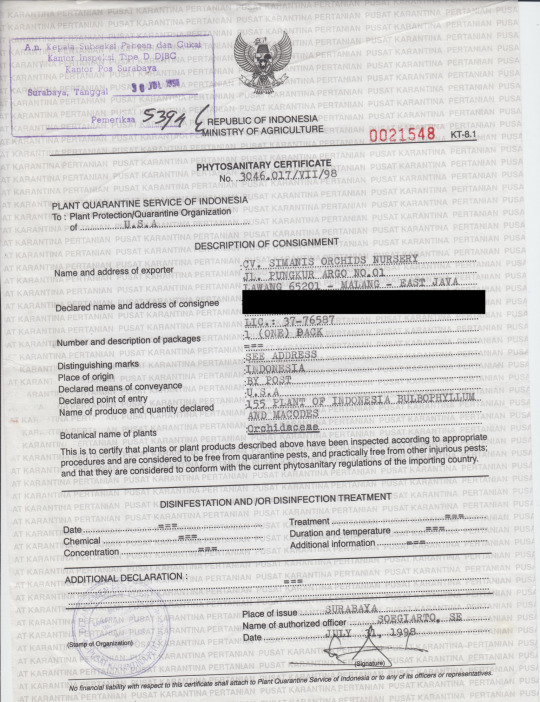
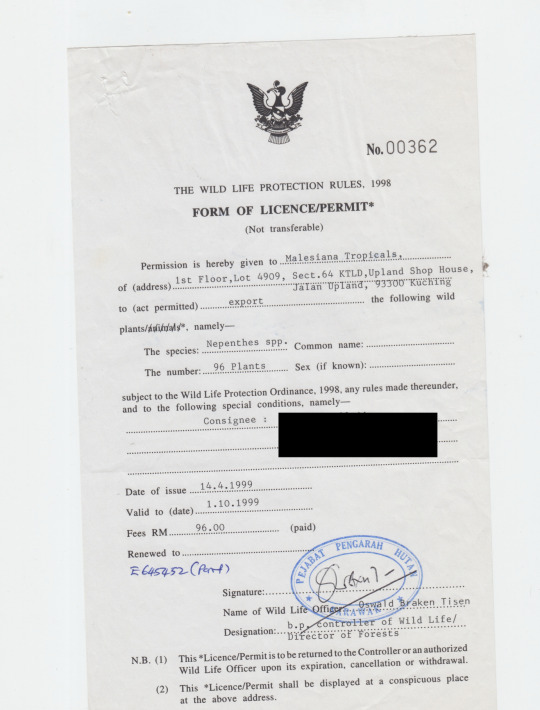

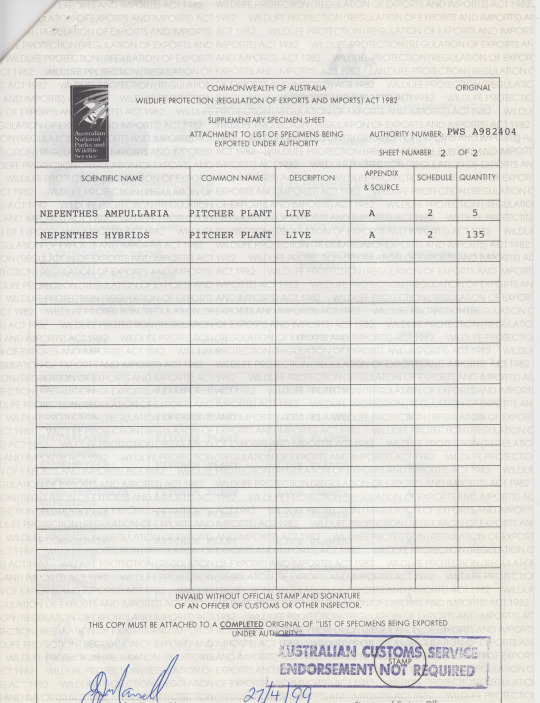
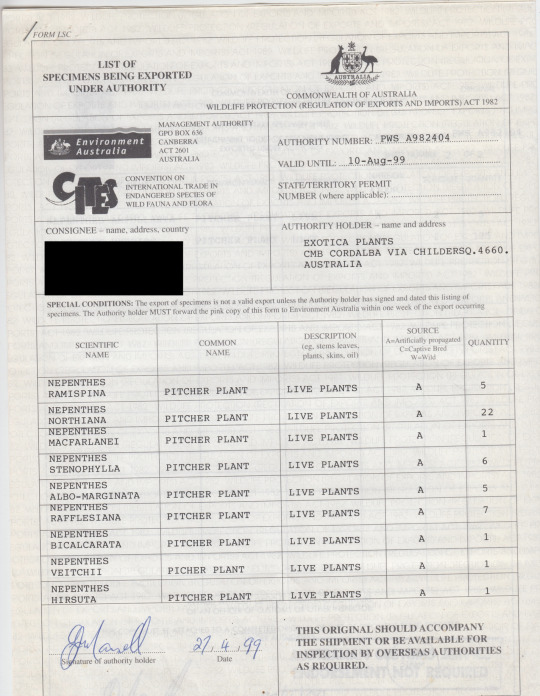
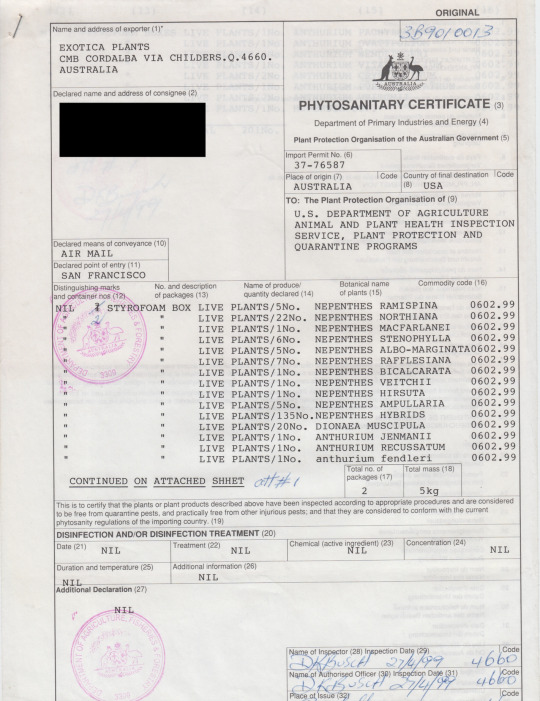
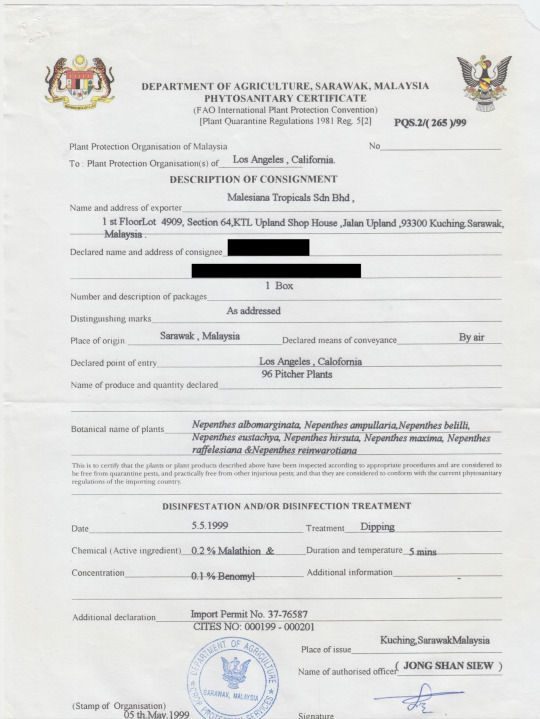
ok INCREDIBLY old content originally meant for this blog but in 2018 when i was just a wee lad with a little spinner propeller hat and big rainbow lollipop i went to a carnivorous plant convention in california and met a bunch of people who breed/collect/study these guys. one person was this collector who was slowly working on leaving the hobby or at least no longer growing plants, and he had a bunch of carnivorous plant related files he was charging like 50 cents for or something, and so i came into possession of these, which are examples of the kind of paperwork you have to have done to legally ship/trade endangered species of both plants and animals. functionally very boring paperwork, but something i found like, incredibly fascinating. i blacked out the personal id of the person and then immediately forgot to ever upload them, lmao.
these plants were bred and raised in a greenhouse and sold abroad, not taken from the wild, but because the species are endangered and often protected in their native countries (most of these are nepenthes, asian pitcher plants, a huge family spread throughout oceania and southeast asia), there's a lot more documentation that needs to be done regardless of their origin, both on the end of the seller and on the end of the buyer.
the rabbit hole on carnivorous plant trade is deep and kind of wild. there's plenty of common, non-threatened, greenhouse-grown pitcher plants on the market that people buy all the time, even non-collectors, but there's a whole debate to be had on if it's morally okay to be collecting the more endangered/rare of these plants in the first place. the big argument for breeding is that breeding them in captivity means there's more supply that's not poached from the wild, meaning poachers have less of an incentive to take the risk of taking adult plants from their habitats; from what i've heard, sometimes countries will issue permits for breeders to collect some wild seeds just to create a non-wild breeding pool to drive down the price. predictably, however, you also get people who are very much willing to pay a lot of money to get as rare of a plant as possible.
anyone familiar with the allure valuable plants have had over people throughout history can imagine the rest, but here's an article about a guy who started buying poached plants to enrich his private nepenthes collection, who then got busted by a fish and wildlife service agent embedded in his carvirorous plant circle. the plants this guy was buying were being sold to him without any CITES paperwork or declarations like the ones above; it was literally just a guy in indonesia taking rare plants from the woods around where he lived, selling them over facebook marketplace and ebay, and mailing them overseas as an undeclared 'gift' to get around customs. frighteningly small steps to take on all sides, to be honest.
(also, fun fact: another example of carnivorous plants that get poached are wild venus fly traps, which are only native to north and south carolina in the US. from what i understand it's a mix of people who genuinely did not know it's a native species and people who really are just going out into the woods and digging up plants to sell online. sometimes poaching is closer to home than you'd think!)
anyway. wild and interesting times in the land of plants recovered from a hard drive lmao
#nepenthes#annual 'plant poaching happens and it doesnt always look like the movies' post i suppose but also i think its really interesting#also the CITES system could do with an overhaul in how it approaches plants as well from what i understand but thats another thing#ive heard that like many systems like this they do not have the same urgency for plants as they do for animals#mostly because people just!! they dont get plants man!! they just say whatever its a plant!!#and poaching in general is only ever talked about like its with taking elephants for their tusks and stuff#also important conservation work but sometimes poaching really is just a guy with a shovel and that shit is WILD#carnivorous plants
525 notes
·
View notes
Text
Millions of U.S. apples were almost left to rot. Now, they'll go to hungry families
NOVEMBER 27, 2023 By Alan Jinich
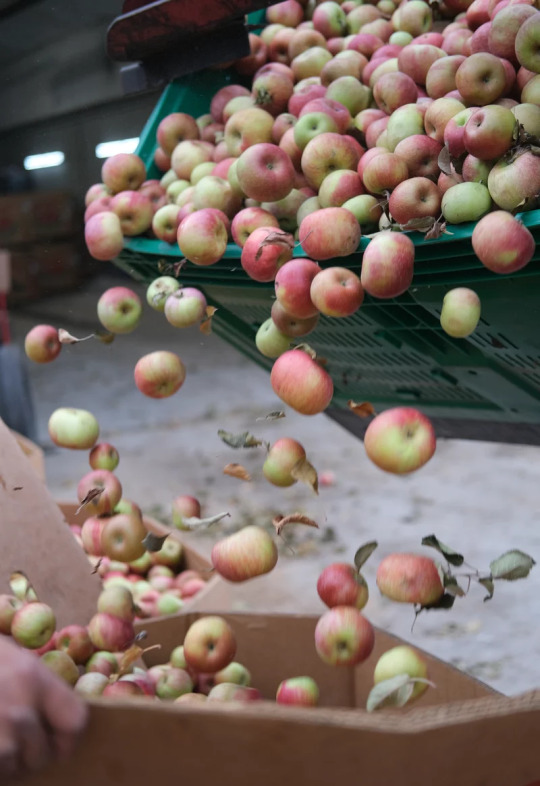
It's getting late in the harvest season in Berkeley County, West Virginia and Carla Kitchen's team is in the process of hand-picking nearly half a million pounds of apples. In a normal year, Kitchen would sell to processors like Andros that make applesauce, concentrate, and other products. But this year they turned her away. ... Across the country, growers were left without a market. Due to an oversupply carried over from last year's harvest, growers were faced with a game-time economic decision: Should they pay the labor to harvest, crossing their fingers for a buyer to come along, or simply leave the apples to rot?
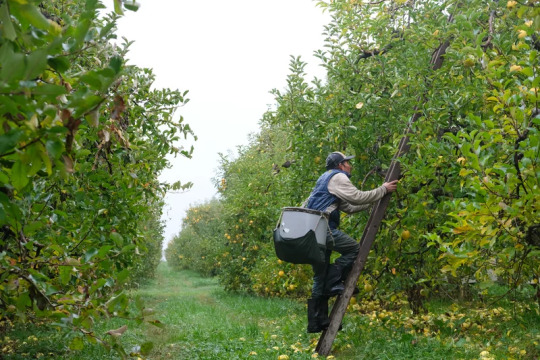
Bumper crops, export declines and the weather have contributed to the apple crisis
... While many growers in neighboring states like Maryland and Virginia left their apples to drop. Sen. Joe Manchin of West Virginia was able to convince the United States Department of Agriculture (USDA) to pay for the apples produced by growers in his state, which only makes up 1% of the national market.
A relief program in West Virginia donated its surplus apples to hunger-fighting charities
This apple relief program, covered under Section 32 of the Agricultural Adjustment Act of 1935, purchased $10 million worth of apples from a dozen West Virginia growers. Those apples were then donated to hunger-fighting charities across the country from South Carolina and Michigan all the way out to The Navajo Nation.

Mike Meyer, head of advocacy at The Farmlink Project, says it's the largest food rescue they've ever done and they hope it can serve as a model for their future missions. "There's over 100 billion pounds of produce waste in this country every year; we only need seven billion to drive food insecurity to zero," Meyer says. "We're very happy to have this opportunity. We get to support farmers, we get to fight hunger with an apple. It's one of the most nutritional items we can get into the hands of the food insecure."
At Timber Ridge Fruit Farm in Virginia, owners Cordell and Kim Watt watch a truck from The Farmlink Project load up on their apples before driving out to a food pantry in Bethesda, Md. Despite being headquartered in Virginia, Timber Ridge was able to participate in the apple rescue since they own orchards in West Virginia as well. Cordell is a third-generation grower here and he says they've never had to deal with a surplus this large.
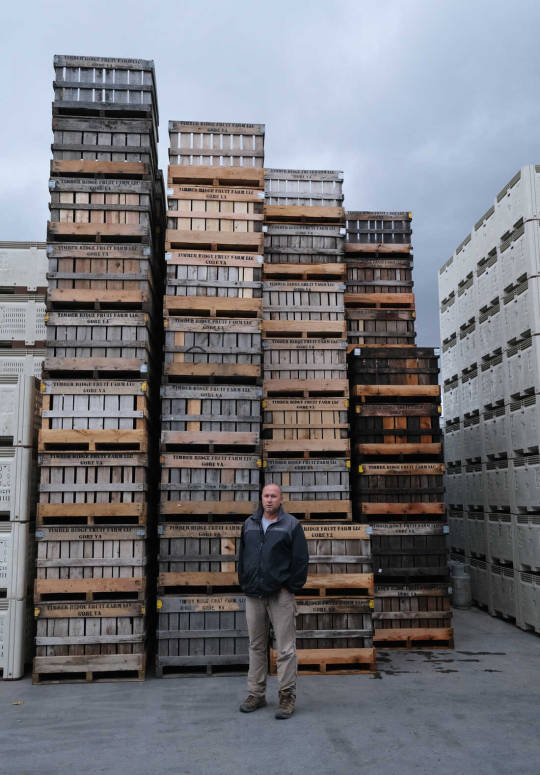
At the So What Else food pantry in Bethesda, Md., apple pallets from Timber Ridge fill the warehouse up to the ceiling. Emanuel Ibanez and other volunteers are picking through the crates, bagging fresh apples into family-sized loads. "I'm just bewildered," Ibanez says. "We have a warehouse full of apples and I can barely walk through it." "People in need got nutritious food out of this program. And that's the most important thing" Executive director Megan Joe says this is the largest shipment of produce they've ever distributed – 10 truckloads over the span of three weeks. The food pantry typically serves 6,000 families, but this shipment has reached a much wider circle. "My coworkers are like, 'Megan, do we really need this many?' And I'm like, yes!" Joe says. "The growing prices in the grocery stores are really tough for a lot of families. And it's honestly gotten worse since COVID."
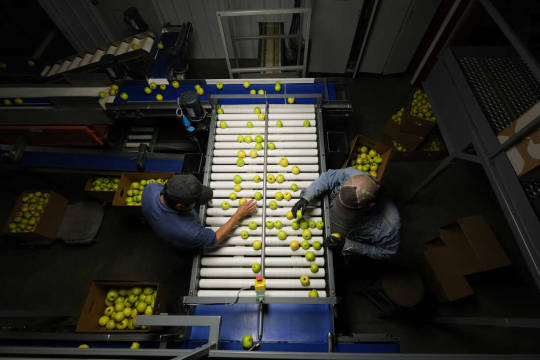
"It's the first time we've done this type of program, but we believe it can set the stage for the region," Kent Leonhardt, West Virginia's commissioner of agriculture says. "People in need got nutritious food out of this program. And that's the most important thing." Following West Virginia's rescue program, the USDA announced an additional $100 million purchase to relieve the apple surplus in other states around the country. This is the largest government buy of apples and apple products to date. But with the harvest window coming to an end, many growers have already left their apples to drop and rot.
192 notes
·
View notes
Text
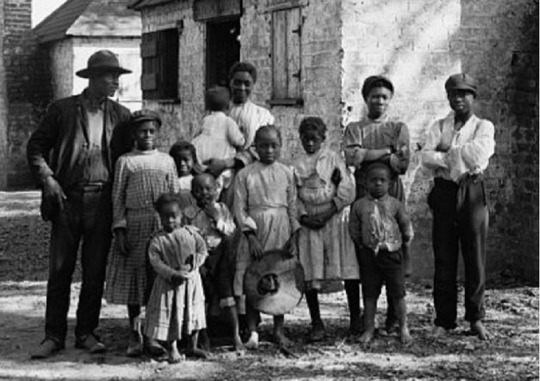
There are short stories, memoirs and novels written by White Southerners after the Civil War that tend to justify slavery. Some of these novels have made slave Christmases sound like beautiful times, writing about how enslaved men and women sang, danced and sat feasting on special meals during Christmas holidays, just as their owners did.
Some of these memoirs state that enslaved people wore their best clothes during Christmas and even played holiday games with their owners. But in reality, Christmas was never really a wonderful time of the year for enslaved people as these memoirs by White Southerners would want people to think.
It is true that many enslaved people got some time off from work during Christmas. The season becomes their longest break of the year, a break between the end of the harvest season and the start of preparation for the following year of production. They could travel to see their family or get married or partake in certain activities that they didn’t get to do at other times of the year.
“This time we regarded as our own, by the grace of our masters; and we therefore used or abused it nearly as we pleased,” abolitionist Frederick Douglass, who escaped slavery in his 20s, wrote. “Those of us who had families at a distance were generally allowed to spend the whole six days [between Christmas and New Year’s Day] in their society.”
Some enslaved men and women also received gifts from their owners — clothing, shoes or money — and ate special meals that they never tasted at other times of the year. But not all enslaved people got the above privileges, and with those who had these privileges, their owners could take back those privileges at any time. Some slaveowners even continued to brutally punish their slaves during Christmas.
It is documented that on one South Carolina plantation, a slaveowner locked up an enslaved woman during Christmas after accusing her of deliberately miscarrying her pregnancy. Runaway slave Gordon, who was nicknamed “Whipped Peter”, was photographed at a union camp upon escaping slavery in the south. Gordon’s photograph displaying his very conspicuous scourged back stunned Americans in the north. Sources say he was whipped at Christmas.
During Christmas, some slaveowners also forced enslaved workers to wrestle with each other to amuse the household or the slaveowners’ family. Other slaves were forced to get drunk by their owners. Some slaveholders also continued to buy and sell enslaved workers during the holidays. Other slaves were even shipped off, far away from their families.
Indeed, Christmas was not a good time for many enslaved people in America. As such, many took advantage of the holidays to plot their escape. In December 1848, Ellen and William Craft, an enslaved married couple from Macon, Georgia, used passes from their owners during Christmas to plan their escape. They boarded trains and a steamboat to Philadelphia. Harriet Tubman also helped her three brothers enslaved in Maryland to escape during Christmas in 1854.
And as Christmas became an opportunity for resistance, some slaveowners feared rebellion during the season. So they often armed themselves during the period or banned Black people from the streets amid intense security. Slaves who proved stubborn or their owners felt were acting strange were whipped or killed. These and many other disturbing moments made Christmas almost unwelcome for America’s enslaved people.
Even for those who received gifts, their owners were just reinforcing their control over them. Historian Stephen Nissenbaum writes that one slaveowner said giving gifts to enslaved people on Christmas was a more appropriate tool to control them than physical violence.
“I killed twenty-eight head of beef for the people’s Christmas dinner. I can do more with them in this way than if all the hides of the cattle were made into lashes,” he said.
#How did America’s enslaved people spend Christmas?#american enslavement of Black People#american history#christmas
26 notes
·
View notes
Text
How to Sell Land Quickly in the Southeast and Beyond: A Comprehensive Guide
If you’re looking to sell your land, understanding the market and targeting the right buyers is crucial. Whether you’re in Georgia, North Carolina, South Carolina, Tennessee, or Michigan, this guide will help you navigate the process. From finding reputable land buyers to learning how to sell land online, let’s explore how to secure the best deal for your property.

We Buy Land: Quick and Easy Sales Solutions
If you’re looking for a fast sale, companies that advertise we buy land can offer an efficient, hassle-free process. These buyers often purchase land as-is, meaning you won’t need to invest in costly improvements or repairs. It’s a great option for those who want a quick cash offer without navigating the traditional real estate market.
Land Buyers in Georgia: Attracting Local Investors
Georgia’s booming economy and diverse landscapes make it a hotspot for buyers. Land buyers in Georgia are interested in everything from rural farmland to suburban development plots.
Highlight the potential uses of your property — such as agriculture, residential development, or recreational use — to attract serious buyers who are ready to invest. Selling land in Georgia requires a targeted approach. Whether you’re marketing large acreage or smaller plots, showcasing features like access to utilities, proximity to major highways, or unique natural features will help attract buyers. Engaging with local real estate agents and listing platforms can broaden your reach.
Land Buyers in North Carolina: Tap into a Growing Market
With its scenic mountains, bustling cities, and thriving agricultural sector, North Carolina attracts a diverse range of buyers. Land buyers in North Carolina are often looking for properties near popular destinations like Asheville or Raleigh. Highlighting your land’s potential for farming, development, or vacation homes can attract these buyers.
Sell Land in North Carolina: Showcase Your Property’s Value
When you decide to sell land in North Carolina, providing detailed listings with clear photos and descriptions is key. Make sure to include information about zoning, access to utilities, and any unique features. Buyers often look for land that can be used for multiple purposes, so emphasize flexibility.

Land Buyers in South Carolina: Targeting the Right Audience
South Carolina’s charm and economic growth make it an attractive market for buyers. Land buyers in South Carolina are drawn to properties with development potential or natural beauty. Whether you’re selling land for residential use or agriculture, showcasing these aspects can help you secure a fast sale.
Sell Land in South Carolina: Key Strategies
To sell land in South Carolina quickly, make sure your listings emphasize any standout features like water access, wooded areas, or proximity to tourist attractions. Partnering with experienced real estate agents or using online platforms can help you reach a wider audience of potential buyers.
Land Buyers in Tennessee: A Thriving Market for Land Sales
Tennessee offers a mix of urban and rural appeal, making it a desirable location for buyers. Land buyers in Tennessee are often looking for investment opportunities or recreational properties. Highlight the proximity to popular areas like Nashville or the Smoky Mountains to attract interested parties.
Sell Land in Tennessee: How to Stand Out
When you’re ready to sell land in Tennessee, be sure to highlight key attributes like acreage size, access to infrastructure, and zoning flexibility. Marketing your land’s potential for residential, agricultural, or recreational use will draw in more offers from motivated buyers.
Sell My Vacant Land Fast in Michigan: Streamline the Process
If you’re wondering, “How can I sell my vacant land fast Michigan?” the answer lies in connecting with cash buyers and using online platforms. Michigan’s market for vacant land is growing, especially in rural areas. Cash buyers often close quickly, making this a great option for those needing a fast sale.

Sell Land Online: Reach Buyers Nationwide
In today’s digital age, the ability to sell land online opens up opportunities to reach buyers across the country. Online platforms allow you to showcase your property to a wider audience, increasing the likelihood of a quick sale. Be sure to include high-quality photos, detailed descriptions, and clear contact information to engage potential buyers effectively.
Conclusion
Selling land doesn’t have to be a complicated process. Whether you’re targeting land buyers in Georgia, North Carolina, South Carolina, Tennessee, or looking to sell my vacant land fast in Michigan, understanding the local market and leveraging online platforms will help you close the deal quickly. From partnering with we buy land companies to using online listings, these strategies ensure a smooth and profitable sale.
3 notes
·
View notes
Text
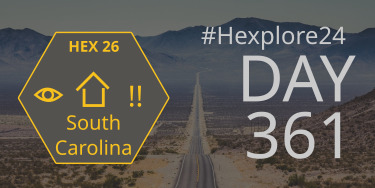
2024-12-26: South Carolina (Hex 26)
Cramped roads are surrounded by marshy forests, the trees draped in Spanish moss that give the limbs a bearded appearance.
Settlement: The Town of Erasmus
Erasmus is a community in a remote part of coastal South Carolina that has long been under the care of Gullah Geechee people. The Gullah Geechee are descendants of chattel slavery who lived on isolated plantations and managed to carve out a distinctive culture that incorporated many of the African traditions of their elders.
Nearly the entire population of Erasmus is Black, and most of the remainder being indigenous people from the Edisto nation/tribe (though it would be 1970 before they officially adopted the Edisto name). The community is defined by outsiders for its arts like basket weaving and textiles, as well as its delicious food.
Few people come this way because of how isolated it is, though more people are stopping by as awareness spreads of how reliably the settlement can be found on The Routes. Most of the travelers through these parts are people of color, though white folks are allowed as long as they don't try to start anything.
Many of the buildings are painted in bright colors, often with murals or patterns. Houses are on the small side (by modern sensibilities), and much of the infrastructure is forced to be simple, sparse, or improvised to cope with a prejudiced lack of investment by moneyed individuals from outside the community (and that's on top of the extra expenses that inevitably pop up when trying to complete any large project so far out in the boonies).
Hidden: The Developer Holdout
A modest house at the end of a long dirt road is the location of a place where the old traditions, stories, and history of the Gullah Geechee are taught. The house is owned by Thursday Molengo, and it is located on land that a developer is looking to acquire. So far Thursday has refused the developer's offers to buy the land, publicly stating that history and traditions matter more than money. Privately, he's willing to sell if the offer is high enough.
Unfortunately for Thursday, no more offers are coming. The developer has struck a sweetheart deal with seize the land through eminent domain. A team of bulldozers are arriving soon to demolish the house, and Thursday would like the party to help hold off the bulldozers for a day or two so that a lawyer friend of his who specializes in fighting government land seizures that take land away from non-white communities. He will arrive in 1d3+1 days, because he is not terribly familiar with The Routes.
Encounter: The Surveyors
A team of three surveyors (Patrick Hughes, Glenn Wilson, and Roy Evans) from the Bureau of Transportation Standardization and Consistency is in the middle of an expedition to document some of the more dangerous sections of The Routes and ran out of food some time ago and are starving from their time being lost. Their car was abandoned some time back when they ran out of fuel. They have money to pay for food, but Patrick will refuse any food offered by or touched by a person of color.
Service Station: Singing Oak Fuel & General Store
In addition to providing gas and diesel to travelers, the Singing Oak is a convenient place for locals to get many of the supplies for daily life. Most of the locals come by on foot because it's so close, so there always seem to be many more people shopping and chatting in the store than there are cars outside. The main building is an older structure probably built during the Great Depression with several bottle trees (shrub-like sculptures with glass bottles covering the branches) guarding the perimeter to ward off malevolent spirits like the Plat-Eye (there are a bunch of different conflicting stories about the Plat-Eye, and I can't find my book of lowcountry ghost stories, so just pick a version that resonates with you and makes sense for your table).
The interior of the shop is lit by several bare bulbs that alternately cover the wares in bright light and deep shadow. The floor is wooden and extremely sturdy despite its age. A grandfather clock that no longer works is afforded a place of honor along one of the walls. Legend says that the clock stopped working the moment the local plantation owner died of old age.
For folks traveling by car, lost objects have a tendency to appear here. There is a 10% chance that a missing object appears in the glove box each time a car visits the store, though the object must be small enough to fit there.
Author's Note: I decided to name this community Erasmus in honor of the group behind Lowcountry Crawl, who have done a wonderful job of condensing the real history and folklore of this part of South Carolina into something that is both informative and fun to play. Although LC is set considerably earlier than 1966, much of the history and folklore still shows up in these rural areas (I speak from experience because much of my childhood was spent in the Lowcountry and the vibes of LC are spot on).
If you are curious about some of the historical Gullah Geechee communities that still exist, look up Hogg Hummock. Another note is about how names for people were chosen: Gullah Geechee names often reflect West African traditions like being named after the day day of the week when a child was born, or giving a child two names (a government name and a "basket name" or "house name" that was known only to family and friends).
2 notes
·
View notes
Text
Quito: Historical City
The night had been dead silent, but the city roared to life around 6am with the road outside the hostel window clearly being a central arterial route. I grabbed a towel from reception and showered, and to my surprise there were two people checking into my dorm room at 8:30am when I was coming out of the bathroom. I had about an hour to wander around the historical city centre and see all the churches and important buildings. It seemed like a lot of shops selling local stuff, toiletries, clothes, hardware and stuff like that so not really anything I wanted to buy. There was a large military presence around the city which made me feel very safe despite the situation recently. I bought two big bottles of water for $0.75 - they use USD here so that’s very convenient for thinking of exchange rate and if I needed to withdraw cash from an ATM. I planned out my route to the northern end of the city with the hostel wifi before I disconnected for the day and headed to the bus stop. After waiting for a few buses to pass and the bus stop becoming totally empty I hopped on one bus and asked for that specific line only for the driver to tell me it doesn’t exist and I needed to take another one and transfer lines. Ecuadorians speak Spanish very slowly and clearly compared to other Central and South American countries so I was able to understand much better and luckily I was already familiar with the route he was describing as I had chosen the direct bus with no transfers instead of that one but alas it was time to try. The ticket booth attendants were very kind and helped me to buy a ticket and take the right bus for the first half of my journey. Immediately as I got on there was a homeless guy begging for money and presumably telling his whole sob story and then I had the displeasure of having another wannabe freestyle rapper getting on with a big speaker thinking everyone wants to hear this shit on their morning commute. I made it successfully to Fankør cafe after asking more people for help as the transfer bus stop was nowhere near where Google maps put it! Rewarding myself with a cappuccino and French toast I sat outside enjoying the sunshine and perfect temperature of Quito, the equatorial city. After my brunch I went for a walk in the Parque la Carolina where I sat and watched a little dog called Teddy running around the dog park for a while. I walked down to Il Barista cafe as I still had an hour to kill before my tour to the middle of the world. It’s odd, they have traffic lights here but they don’t have any crossings or pedestrian lights to help you cross on foot except for at the odd very big intersection. You sort of have to watch the traffic and hope for the best running your way across (hard for me to run with my ankle in a brace…). After my average cappuccino I took an Uber to the tour meeting point about 10-15 minutes away for a total of $1.87. Don’t know why I faffed around with buses honestly!
3 notes
·
View notes
Text

Thomas Paine by Laurent Dabos (1791)
“The Sudden Emergence of Tom Paine
At the beginning of 1776, New England was ready for independence. So were such leading radicals as Richard Henry Lee and Patrick Henry of Virginia, Christopher Gadsden of South Carolina, and army leaders such as George Washington and Charles Lee. But the bulk of the colonies and the Continental Congress were not. One of the main stumbling blocks to a commitment to independence was personal loyalty to the British crown. There has always been a political taboo of almost mystical force against attacking the head of state, and always the convenient though emasculating custom of attributing his sins to his evil or incompetent advisers. Such long-standing habits impeded a rational analysis of the deeds of King George III. Furthermore, the old and obsolete Whig ideal of virtual independence under a figurehead king of both Britain and America could only be shattered if the king were to be attacked personally.
To rupture this taboo, to smash the icon, and so to liberate America from its thrall required a special type of man, a man fearless, courageous, and radical, an intellectual with a gift for dramatic and exciting rhetoric and unfettered by the many ties that bind a man to the existing system. At this strategic hour America found just such a man: Thomas Paine.
Unlike most of the other eminent leaders of his day, there was nothing in the least aristocratic in the background of Tom Paine. The son of a poor English corset maker, he was forced to educate himself for lack of schooling. After serving a checkered career as corset maker, sailor, and petty bureaucrat, he finally rose to the status of a minor English tax collector. He was soon characteristically in trouble with the authorities. Chosen by his fellow excise collectors in 1772 to petition Parliament for higher wages, he was curtly dismissed from the service by the authorities. Unemployed, bankrupt, the unhappy Paine began his life again at the age of thirty-seven by emigrating to America, armed only with a letter of introduction he had managed to obtain from Benjamin Franklin in London.
Landing in Philadelphia toward the end of 1774, he got a job with a Philadelphia printer and soon rose to the editorship of the printer's insignificant Pennsylvania Magazine. He quickly proved himself an outstanding writer and publicist and quickly made his reputation as a libertarian by publishing a blistering attack on the institution of slavery. In "African Slavery in America," written shortly after his arrival and published in early March 1775, Paine pointed out that the African natives were often peaceful and industrious farmers brought into slavery either by European man-theft or by outsiders inducing the African chieftains to war on each other and to sell their prisoners into slavery. He also riddled the common excuse that purchase and ownership of existing slaves was somehow moral, in contrast to the wickedness of the original enslavement: "Such men may as well join with a known band of robbers, buy their ill-got goods, and help on the trade; ignorance is no more pleadable in one case than the other . . . and as the true owner has the right to reclaim his goods that were stolen, and sold; so the slave, who is proper owner of his freedom, has a right to reclaim it, however often sold." The slaves, being human, have not lost their natural right to their freedom, and therefore, concluded Paine, "the governments . . . should in justice set them free, and punish those who hold them in slavery."
Shortly after this article was published, the first abolitionist society—The Society for the Promotion of the Abolition of Slavery—was established at Philadelphia. Largely Quaker, it included the deist Paine as one of its members.
Lexington and Concord moved Paine to turn his talents to the radical revolutionary cause. In July he urged upon the Quakers the justice of taking up arms in defense of liberty so long as disarmament is not universal. He denounced the British government as highwaymen setting forth to plunder American property; therefore, in self defense, "arms like laws discourage and keep the invader and plunderer in awe." For the British, "nothing but arms or miracles can reduce them to reason and moderation." And in October he combined his antislavery and proindependence views to castigate Great Britain for trafficking in human flesh, and he looked forward to an independence that would end the slave trade and, ultimately, all of slavery.
All this culminated in Paine's tremendous blow for American independence. His fiery and brilliant pamphlet Common Sense, off the press in early January 1776, spread like wildfire throughout the colonies. A phenomenal 120,000 copies were sold in the space of three months. Passages were reprinted in newspapers all over America. All this meant that nearly every literate home was familiar with the pamphlet. Tom Paine had, at a single blow, become the voice of the American Revolution and the greatest single force in propelling it to completion and independence. Charles Lee wrote jubilantly and prophetically to Washington that "I never saw such a masterly, irresistible performance. It will . . . in concurrence with the transcendent folly and wickedness of the ministry, give the coup de grace to Great Britain." And Washington himself endorsed "the sound doctrine and unanswerable reasoning" of Common Sense.
Common Sense called squarely and openly for American independence, and pointed to the choice for Americans as essentially between independence and slavery. But what was more, Paine boldly smashed the icon, directing his most devastating fire at King George himself. For the first time, the king, "the Royal Brute of Great Britain," was pinpointed as the major enemy—the king himself, not just his wicked advisers (the king's advisers were attacked as being in thrall to him). Paine had quashed the taboo, and Americans flocked to imbibe his liberating message.
Not stopping at indicting George III, Paine pressed on to a comprehensive attack on the very principle of monarchy. The ancient Jews had prospered without kings and had suffered under them, he wrote, following the great English tradition of Milton and Sidney; and Holland flourished as a republic. But more important, the division between kings and subjects is unnatural, and bears no relation to the natural distinction between rich and poor on the market. How, indeed, had the natural equality of men before the law become transposed into subjection to a monarch? "We should find the first of them [kings] nothing better than the principal ruffian of some restless gang; whose savage manners or pre-eminence in subtilty obtained him the title of chief among plunderers; and who by increasing in power and extending his depredations, overawed the quiet and defenseless . . . . “ And now the kings were but "crowned ruffians."
In this way, Paine not only laid bare the roots of monarchy, but provided a brilliant insight into the nature and origins of the State itself. He had made a crucial advance in libertarian theory upon the social-contract doctrine of the origin of the State. While he followed Locke in holding that the State should be confined to the protection of man's natural rights, he saw clearly that actual states had not originated in this way or for this purpose. Instead, they had been born in naked conquest and plunder.
Another vital contribution of Common Sense to libertarian thought was Paine's sharp quasi-anarchistic distinction between "society" and "government." Indeed, Paine opened his pamphlet with these words:
Some writers have so confounded society with government, as to leave litte or no distinction between them; whereas they are not only different, but have different origins. Society is produced by our wants and governed by our wickedness. . . . The one encourages intercourse, the other creates distinctions. The first is a patron, the last a punisher.
Society in every state, is a blessing, but government, even in its best state, is but a necessary evil; in its worst state an intolerable one: for when we suffer . . . the same miseries by a government, which we might expect in a country without government, our calamity is heightened by reflecting that we furnish the means by which we suffer. Government, like dress, is the badge of lost innocence; the palaces of kings are built upon the ruins of the bowers of paradise.
In addition to limning brilliantly the nature and origins of monarchy and the State, calling boldly for independence, and attacking George III, Paine set forth the proper foreign policy for an independent America. Here he argued that the connection with Great Britain entailed upon Americans burdens rather than rewards. The Americans should not be tempted by the prospect of Anglo-American domination of the world; on the contrary, America would vastly benefit from throwing open its trade and ports freely to all nations. Further, the alliance with Britain "tends directly to involve this continent in European wars and quarrels, and set us at variance with nations . . . against whom we have neither anger nor complaint." As Europe is our market for trade, we ought to form no partial connection with any part of it. It is the true interest of America to steer clear of European contentions, which she can never do while "she is made the make-weight in the scale of British politics." Thus, Paine adumbrated for America what was later to be called a foreign policy of "isolationism," but which might also be called neutrality or neutralism. Whatever it is called, it is essentially the libertarian policy of free trade and peaceful coexistence with all nations; it is an America that acts as a moral beacon for mankind rather than as judge or policeman.
In addition to all these achievements, Paine managed to outline in this brief pamphlet the internal political program of the libertarian wing of the American Revolution: the new democratic system naturally created by the Revolution. This consisted of rule by democratically elected legislatures established by proportionate representation and responsible to checks upon them by the people. The aim of such government was simply to protect every man's natural rights of liberty and property: "Securing freedom and property to all men, and above all things, the free exercise of religion. . . ." He saw that the superficially plausible lucubrations of such Tory writers as Montesquieu and Blackstone, with their talk of mixed constitutions and checks and balances, masked the repression and hobbling of the democratic element by unchecked aristocracy and oligarchy. Human reason, he implied, must be brought to bear on the myths and accretions of government itself. The much-vaunted British constitution was a tangle of complexities, and hence vague and devoid of a focus of responsibility. In effect, he charged, the so-called checks and balances have led to the aggrandizement of monarchical tyranny over the other branches of government. Indeed, at any given time, for government to act at all, one of the branches must predominate and outweigh the checks and balances. This argument is reminiscent of Edmund Burke's blast against the idea of mixed and balanced government in his anarchistic first work, The Vindication of Natural Society.
Paine concluded the bulk of his magnificent pamphlet with these stirring lines: "O! Ye that love mankind! Ye that dare oppose not only the tyranny but the tyrant, stand forth! Every spot of the old world is overrun with oppression. Freedom hath been hunted round the globe. . . . O! Receive the fugitive, and prepare in time an asylum for mankind." Sounding the clarion call for the democratic-libertarian cause as the party of hope, the party of progress, in short, the party of a secular, rational messianism, he eloquently hailed the impending future: "We have it in our power to begin the world over again. . . . The birthday of a new world is at hand. . . .”
The explosive success of Common Sense emboldened the radicals to follow with pamphlets and articles extolling the goal of independence, excoriating King George as "a full-blooded Nero," and anticipating the great benefits of free trade with all the world that would flow from an independent status.
That the Tories, and quasi Tories, and conservatives who opposed independence should abominate Common Sense was, of course, to be expected, reviling it as that "artful, insidious and pernicious" work of sedition and "phrenzy." Several Tories hastened to publish pamphlets of rebuttal, warning of the "ruin, horror, and desolation" that would stem from abandoning the happy and peaceful status of a colony to pursue the romantic chimera of independence. Independence was roundly denounced as absurdly impractical and "Utopian," a project of "ambitious innovators" who "are attempting to hurry... into a scene of anarchy; their scheme of independence is visionary. . . ." Conservative landed oligarchs such as Landon Carter and Henry Laurens considered the Paine pamphlet as "indecent," "rascally," and "dangerous." But the Tories and conservatives soon found that their attacks on independence were in vain, that "there is a fascination belonging to the word Liberty that beguiles the minds of the vulgar. . . ."“ - Murray Rothbard, ‘Conceived in Liberty, Volume IV: The Revolutionary War, 1775-1784’ (1975) [p. 135 - 140]
#rothbard#murray rothbard#liberty#conceived in liberty#paine#thomas paine#common sense#dabos#laurent dabos#america#independence#revolution#rebellion#British#empire#monarchy#slavery#libertarian#libertarianism#economics#austrian economics#history#revisionism#george washington#benjamin franklin#burke#edmund burke
4 notes
·
View notes
Text
"The delayed clarity on what exactly happened in Jersey City muted some of the public empathy that instantly followed the previous attacks. So did the identities of the attackers, both of whom were Black, and their targets, who were Hasidic Jews - who, it has progressively become clear, many otherwise enlightened Americans view as absolutely fair game for bigotry.
This was obvious from reporting within hours of the attacks, which gave surprising emphasis to the murdered Jews as "gentrifying" a "minority" neighborhood. This was remarkable, given that the tiny Hasidic community in question, highly visible members of the world's most consistently persecuted minority, in fact came to Jersey City fleeing gentrification, after being priced out of long-established Hasidic communities in Brooklyn. More tellingly, as the journalist Armin Rosen has pointed out, the apparently murderous rage against gentrification has yet to result in anyone using automatic weapons to blow away white hipsters at the newest Blue Bottle Coffee franchise. What was most remarkable about this angle, however, was how it was presented in media reports as providing "context."
The "context" supplied by news outlets after this attack was breathtaking in its cruelty. As the Associated Press explained in a news report about the Jersey Cijty murders that was picked up by NBC and many other outlets, "The slayings happened in a neighborhood where Hasidic families had recently been relocating, amid pushback from some local officials who complained about representatives of the community going door to door, offering to buy homes at Brooklyn prices." (Like many homeowners, I too have been approached by real estate agents asking me if I wanted to sell my home. I recall saying no, though I suppose murdering these people would also have made them go away.) New Jersey's state newspaper, the Star-Ledger, helpfully pointed out that "the attack that killed two Orthodox Jews, an Ecuadorian immigrant and a Jersey City police detective has highlighted racial tension that had been simmering ever since ultra-Orthodox Jews began moving to a lower-income community" - even though the assailants never lived in Jersey City and apparently chose their target simply through internet searches for Jewish institutions in the New York area. The Washington Post began its analysis of the murders by announcing that Jersey City "is grappling with whether the attack reflects underlying ethnic tensions locally and fears that it could spark new ones" - even though the rest of the article described in detail how "longtime black residents and ultra-Orthodox implants alike say that they haven't experienced significant ethnic tensions here." Nonetheless, readers were informed, "the influx of Hasidic residents comes as many of the longtime black residents feel increasingly squeezed." This was all abut gentrification, the public learned. The assailants, who wore socially acceptable clothing, were expressing an understandable communal sentiment. The newly dead Jews, on the other hand, were members of the unharassed majority, despite being the country's top hate-crime target according to the FBI. They were also rich, despite experiencing the same poverty levels as the rest of New York and New Jersey. On top of that, they wore unfashionable hats. So it kind of made sense that people wanted to murder their children with high-impact explosives.
I was not able to find any similar "context" in media reports after the 2015 massacre at a Black church in Charleston, South Carolina, or the 2016 massacre at an LGBTQ nightclub in Orlando, Florida, or the 2019 massacre at a Walmart in El Paso, Texas frequented by Latino shoppers - all hate-crime attacks that unambiguously targeted minority groups. In each of those cases, as was true in Jersey City, media coverage included sympathetic pieces about the victims, along with investigative pieces about the perpetrators, the latter focused on how perpetrators were drawn into violent irrational hatred. But in reviewing media reports from the aftermath of these events, I found no coverage of how straight people in Orlando other than the perpetrator - in other words, reasonable, non-murderous, relatable "normal" neighbors - were understandably upset about gay couples setting up shop in the neighborhood and disrupting their "way of life," or about how white people with deep family roots in Charleston felt understandably wistful about the Black community's "takeover" of certain previously white neighborhoods, or about how non-Latinos in El Paso felt "squeezed" by ongoing "tensions" with Latinos who had pushed for more bilingualism in schools.
No one covered this "context," because doing that would be bonkers. It would be hateful victim-blaming, the equivalent of analyzing the flattering selfies of a rape victim in lurid detail in order to provide "context" for a sexual assault. That doesn't mean the intergroup tensions (or the problems with flattering selfies) aren't ever worth examining. It simply means that presenting such analysis as a hot take after a massacre is not merely disgusting and inhuman, but also a form of the very same hatred that caused the massacre - because the sole motivation for providing such "context" in that moment is to inform the public that those people got what was coming to them. People who think of themselves as educated and ethical don't do this, because it is both factually untrue and morally wrong. But if we're talking about Hasidic Jews, it is quite literally a different story, and there is one very simple reason why.
The mental gymnastics required to get the Jersey City attack out of my head were challenging, especially when the Jewish community int he New York area was treated in the two weeks following this massacre to more than a dozen other assaults of varying degrees, most of them coming during the festival of Hanukkah. These included Jews being slapped, punched, kicked, and beaten on the streets by people who made their motives clear by shouting antisemtiic insults, and many other variants on this theme that received much less attention. (One that shook me personally was when a young white man broke into my students' dormitory at yeshiva University at four a.m. and started a fire - using matches from the dorm lobby's Hanukkah candle-lighting.) All this was merely an intensified version of physical assaults on Hasidic Jews in New York that had been happening regularly for over a year - incidents that ranged from run-of-the-mill acts of knocking elderly people to the ground to the rather more advanced tactic of clobbering someone over the head with a large paving stone, causing a fractured skull.
This new normal culminated in a particularly horrifying attack, when a man entered a crowded Hanukkah party at a Hasidic rabbi's house in Monsey, New York, wielding a four-foot machete, and stabbed or slashed five people, all of whom where hospitalized; one victim, who fell into a coma, died several months later from his wounds. Stabbing Jews was apparently in vogue in Monsey, as this was actually the second antisemitic knifing in town in just over a month. The previous attacks victim was beaten and stabbed while walking to morning prayers, winding up in critical condition withe head injuries. Media coverage of these attacks also sometimes featured "context" (read: gaslighting), mentioning heated schoolboard or zoning battles between Hasidic and non-Hasidic residents - even after the perpetrator was identified as a resident of a town forty minutes away. One widely syndicated Associated Press article situated the previous week's bloodbath by informing millions of readers that "The expansion of Hasidic communities in New York's Hudson Valley, the Catskills and northern New Jersey has led to predictable sparring over new housing development and local political control. It has also led to flare-ups of rhetoric seen by some as antisemitic." In other words, the cause of bloodthirsty antisemitic violence is...Jews, living in a place! Sometimes, Jews who live in places even buy land on which to live. To be fair, there were many countries and centuries in which this Jews-owning-land monkey business was illegal, though twenty-first-century Hudson Valley, the Catskills, and northern New Jersey are sadly not among those enlightened locales. Predictably, this leads to sparring, and flare-ups. Who wouldn't express frustrations with municipal politics by hacking people with a machete?"
- Dara Horn, People Love Dead Jews: Reports from a Haunted Present
6 notes
·
View notes
Video
youtube
Active Adults 55+ and Better Coming to Bluffton South Carolina
#youtube#Active Adults 55+ and Better Coming to Bluffton South Carolina Buy home build home sell home 55 plus communities in Bluffton sun city hilton
0 notes
Text
The Benifits of Sell My House Fast In South Carolina
In the bustling real estate landscape of South Carolina, homeowners often find themselves at crossroads when it comes to selling their properties swiftly and efficiently. The demand for quick and hassle-free property transactions has given rise to a thriving market for selling houses rapidly. In this informative article, we will delve into the intricacies of this niche market, shedding light on various aspects associated with selling your house fast in the Palmetto State.
The Need for Speed: Sell My House Fast SC In the competitive South Carolina real estate market, timing is crucial. We'll explore why homeowners may want to sell their properties swiftly and the benefits of doing so. From job relocations to financial emergencies, various factors can prompt the need to "sell my house fast South Carolina."
The Role of Cash Home Buyers: A Game Changer Cash home buyers play a pivotal role in expediting the selling process. We'll discuss how these investors operate, what sets them apart, and why many homeowners turn to them when searching for "cash for my house SC."
We Buy Houses South Carolina While the urge to "sell my house for cash South Carolina" is strong, it's essential to determine if you're getting a fair deal. We'll delve into the intricacies of property valuation and how to ensure you're not sacrificing value for speed.
The South Carolina Real Estate Landscape: Cash for My House South Carolina Understanding the current real estate trends in South Carolina is crucial when considering a quick sale. We'll explore the local market conditions, demand, and supply factors that impact your decision to "sell my house fast for cash South Carolina."
Step-by-Step Guide to Sell My House Fast for Cash SC Selling your house quickly involves a streamlined process. We'll break down the essential steps, from preparing your property for sale to closing the deal with cash home buyers. This section will serve as a comprehensive guide for anyone looking to "buy my house SC."
Overcoming Challenges: The Cash Home Buyers Despite the benefits, selling your house fast can come with challenges. We'll discuss common obstacles and how to address them effectively, ensuring a smooth and successful transaction.
Buy My House South Carolina Finally, we'll sum up the article by encouraging readers to make informed decisions when exploring the options available for selling their homes quickly. By understanding the nuances of the market and the role of cash home buyers, homeowners can confidently pursue their goal to "sell my house fast SC."
Now, let's delve into each of these sections to provide a comprehensive and informative article on selling houses quickly in South Carolina.
#sell my house fast South Carolina#sell my house fast SC#sell my house for cash South Carolina#sell my house for cash SC#we buy houses South Carolina#we buy houses SC#cash home buyers South Carolina
1 note
·
View note
Text
Okay no one asked! But! Today You Learned about Outhouse Springs.
If you lived in/drove through South Carolina in the early 2000’s, you probably saw one of these signs:

Yup, these were ads for a brand of recycled water called “Outhouse Springs.” If that sounds gross, then yes, that’s the point. Because this wasn’t a real product, it was an ad campaign by a billboard company to show how effective they could be in stirring up interest in a fake product. People went looking for this in stores (I know I did, though I didn’t want my parents to buy any of it). Apparently enough people asked about it that they did eventually start selling bottled water with the label, though the brand didn’t last, and I have no idea if the stuff they sold was ACTUALLY recycled water.
10 notes
·
View notes
Text
Some of my favorite things my Blorbo from University has done in the classes I've had with him
- He has a thing about "I'm not supposed to teach y'all about "radical" topics like, I don't know, how black people have been oppressed in this country since forever, so once I finish this lecture on Jim Crow laws y'all can send me off to the gulag." And regularly references getting sent to the gulag after lectures.
- He and I have a silly little feud because he's a North Carolinian and I'm a South Carolinian and one time the class joked that we'd ship him off to South Carolina instead of the gulag and he literally pulled a knife out of his pocket and put it up to his neck in front of the entire lecture hall and said "You'll have to drag my dead fucking body there! I'M NOT GOING BACK!"
- He's literally actually a comedian so he tells a lot of jokes in his lectures and just does general fuckery and my favorite account of this is on the first day of class with him one kid was late and he turned to the lecture hall before the kid came in and said "Guys I'm gonna fuck with him just let it happen. Play it cool." and then he let the guy in and once said guy was seated my professor just started lecturing in fluent Russian
- I have a T-shirt on it that says "World's Sluttiest Dad" and every time I wear the shirt he comments on how it's his favorite shirt he's ever seen but he could never wear it because I'm obviously a way sluttier dad than he is
- I told him I was looking for something specific on Facebook marketplace with just a screenshot to go off of and couldn't find it and he said to send it to him because "I'm an expert at Facebook marketplace on account of my brother -you know, the one in prison- won't stop selling our mom's shit on there and it's always my job to find it and buy it back. I'll find it for you."
- I'm starting a teaching assistant position under him in the fall so he was like "oh fuck yeah I'm not just your teacher now I'm your mentor!" except I am also mentoring under his wife who is the head of the graduate studies program that I want to pursue at our college, and when he found this out he told me (in front of my entire class, mind you) "Mentorship cancelled. You're family now. It's inescapable. When you stand up on the stage at graduation me and my wife are gonna be standing there next to the president and when he gives you your diploma we're gonna give you adoption papers with it."
- He uses a golf cart to get across campus and he told us "I'd run each of you over to get you free tuition but unfortunately I don't have a big enough golf cart... Also my wife said I'd just get fired which would be fine because this college is barely paying me anything anyway but apparently you guys would be stuck with a less cool history professor so I've decided against it."
- Okay for this bullet point it's important that you know two things. 1. He was diagnosed with rectal cancer back in January and 2. During the second or third week of class he was late because his truck got rear-ended in the parking lot by a student. Anyway he was late again like two or three weeks later, and we asked him if he got rear-ended again and he said "Guys I've got rectal cancer; I'm getting rear-ended three days a week!" And only a couple people laughed and he said "Oh come on lighten up! It's not like I'm actually going to the doctor every day and they're like 'Bend over now; we've got the spoon!'...haha... Anyway so during the depression of 1893..." and The Spoon lives rent free in my head now. What the fuck did he mean by that???? Was he implying they'd scoop the cancer out of his ass?????
These are just things he's done that I can think of off the top of my head but I could honestly probably write a book with all the crazy shit he's said and done as my professor
"Blorbo from my shows" no. Blorbo from my BA. Blorbo from my major. Blorbo from my primary source document.
#dots history professor#my mutuals are obsessed with him#i am too tbh#dot says#college#college professor
43K notes
·
View notes
Text
Your Trusted Partner for Hassle-Free Car Shipping in the USA

Your Trusted Partner for Hassle-Free Car Shipping in the USA
When it comes to shipping your car across the USA, whether you’re moving to a new state, buying or selling a vehicle, or simply need a reliable service, finding a trustworthy car shipping company is crucial. At [Your Company Name], we offer the best car transport services across the country, ensuring your vehicle is safely and efficiently delivered to your desired location. Our commitment to excellence and customer satisfaction makes us your trusted partner for hassle-free car shipping in the USA.
Why Choose Us for Car Shipping?
1. Reliable Nationwide Services We understand the importance of timely delivery and the safe transport of your vehicle. With years of experience, we have honed our processes to provide fast, efficient, and secure car shipping services nationwide. From coast to coast, whether you're sending a car from New York to California or Florida to Texas, we’ve got you covered.
2. Affordable Rates for Every Budget Shipping a car doesn’t have to break the bank. At [Your Company Name], we offer competitive and transparent pricing to make car transport accessible for everyone. Our no-hidden-fees policy ensures you won’t encounter unexpected costs. We provide free quotes and are committed to offering the best value for your money.
3. Expert Drivers and Modern Equipment Our team consists of experienced, licensed drivers who understand the importance of handling your car with care. We use modern, well-maintained transport vehicles to ensure your car arrives in perfect condition. Whether you're shipping a luxury car, classic vehicle, or everyday ride, you can count on us to deliver it safely.
4. Convenience and Peace of Mind We know the logistics of car shipping can be daunting, which is why we’ve streamlined the process to make it as simple and stress-free as possible. From the moment you book your shipment until your car is delivered, we’ll keep you updated on the status of your transport, ensuring you have peace of mind every step of the way.
Best Car Transport in South Carolina
For residents of South Carolina, we offer the best car transport services tailored to your needs. Whether you're in Charleston, Columbia, Greenville, or any other city, we provide door-to-door transport for maximum convenience. Our services are especially popular for those moving into or out of South Carolina, a state known for its scenic beauty and growing economy.
South Carolina is a hub for car enthusiasts and vehicle transactions, and we understand the importance of reliable and professional shipping services in this region. Whether you're shipping a car from Myrtle Beach to Hilton Head Island or need to transport a vehicle to or from the Palmetto State, we provide secure and timely car shipping solutions.
How We Ensure a Hassle-Free Experience
We prioritize customer satisfaction, which is why we take every step to make sure your car shipping experience is hassle-free. Here's how we ensure a smooth process:
Clear Communication: From the moment you contact us, we provide clear, honest, and helpful communication. Our customer service team is available to answer all your questions and guide you through the car shipping process.
Flexible Scheduling: We understand that your schedule may vary, which is why we offer flexible pick-up and delivery times to suit your needs.
Safety First: We take extra precautions to protect your vehicle during transport. Our enclosed carriers provide added protection for high-value or delicate cars, ensuring they remain safe from the elements and road debris.
Tracking Your Shipment: With our advanced tracking system, you can monitor the progress of your shipment in real-time. This ensures transparency and gives you peace of mind that your vehicle is on the right path.
Conclusion
When it comes to hassle-free car shipping in the USA, [Your Company Name] is the trusted partner you can rely on. Our expertise in nationwide car transport, combined with our commitment to safety, reliability, and affordability, makes us the best choice for customers looking to ship their vehicles anywhere in the country. If you're looking for the best car transport in South Carolina, look no further—we’re here to serve you with top-notch services tailored to your needs.
Contact us today for a free quote and let us take the stress out of shipping your car!
1 note
·
View note